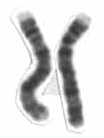
Photo from wikipedia
Translocation that juxtaposes the IGH@ enhancer (Eμ) to a proto-oncogene such as CRLF2, EPOR and DUX4 is a common oncogenic mechanism that drives B-ALL. B-cells achieve immunoglobulin monospecificity by inactivating… Click to show full abstract
Translocation that juxtaposes the IGH@ enhancer (Eμ) to a proto-oncogene such as CRLF2, EPOR and DUX4 is a common oncogenic mechanism that drives B-ALL. B-cells achieve immunoglobulin monospecificity by inactivating one of the IGH alleles during development. We used a combination of long and short read sequencing technologies to investigate the interplay between this allelic exclusion and IGH@ translocation. We compared the allelic specificity of an IGH-DUX4 fusion and full-length IGH (Igμ) in the Nalm6 B-ALL cell line - known to carry an IGH-DUX4 translocation - using whole-genome sequencing (WGS) and RNA-seq with both long-read (i.e. the PacBio Iso-Seq method and Chromium WGS) and short-read technologies (Illumina total stranded RNA and WGS). This was accomplished by calibrating allelic imbalance of heterozygous single nucleotide polymorphisms (SNPs), which were identified by WGS, in the transcriptome, epigenome and 3-D genome structure. Using the Chromium WGS data, we assembled two haplotypes spanning a 23 Kb DNA segment near the IGH-DUX4 fusion region. One of the haplotypes harbored the DUX4-fusion and the other represented the wild-type allele. By mapping long-read Iso-Seq transcripts against the assembled haplotypes, we found that DUX4 and Igμ were transcribed from different haplotypes. Notably, allelic imbalance in RNA-seq, ATAC-seq, and H3K27ac ChIP-seq showed that DUX4 was transcribed at much lower level than Igμ ( Genome-wide Hi-C data showed that DUX4 was regulated by Eμ, the native enhancer of Igμ. Deep sequencing of targeted chromosome conformation capture (Capture-C) revealed that the contact intensity of DUX4 and Eμ is 14-fold lower than that of the Igμ promoter and Eμ. The weaker enhancer-promoter interaction at the DUX4-fusion haplotype may explain the lower expression of DUX4 compared to Igμ. Furthermore, heterozgyous SNPs in the Igμ promoter region were uniformly mono-allelic in Capture-C, confirming that Igμ was transcribed only from one haplotype. Our analysis of Nalm6 shown that, counterintuitively, the IGH-DUX4 fusion occurred on the haplotype that does not express Igμ and the fusion gene exhibited lower expression compared to Igμ. Epigenetic regulation at IGH locus is a plausible explanation as we observed weaker interaction of Eμ to DUX4 than that of Eμ to Igμ. Further examination of published RNA-seq data from 72 B-ALL patient samples that harbor IGH@ translocation showed that the majority had higher (median 6.2 fold, range 2.2-57.1) IGH expression than their partner gene (28 of 32 IGH-DUX4, 16 out of 16 IGH-EPOR and 17 out of 24 IGH-CRLF2). This suggests that the majority of IGH@ translocations in B-ALL may have occurred in the haplotype with allelic exclusion. Citation Format: Liqing Tian, Beisi Xu, Ying Shao, Xiaotu Ma, Yongjin Li, Scott Newman, Xin Zhou, Meredith Ashby, Ting Hon, Tyson Clark, Elizabeth Tseng, John Easton, Jinghui Zhang. Allelic specificity of immunoglobulin heavy chain (IGH) translocation in B-cell acute lymphoblastic leukemia (B-ALL) unveiled by long-read sequencing [abstract]. In: Proceedings of the American Association for Cancer Research Annual Meeting 2018; 2018 Apr 14-18; Chicago, IL. Philadelphia (PA): AACR; Cancer Res 2018;78(13 Suppl):Abstract nr 1485.
Journal Title: Cancer Research
Year Published: 2018
Link to full text (if available)
Share on Social Media: Sign Up to like & get
recommendations!